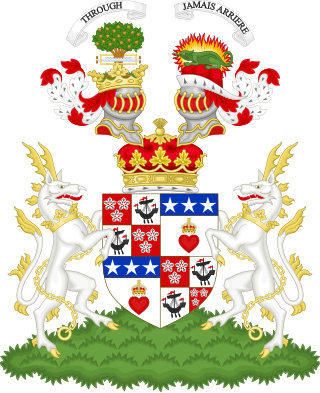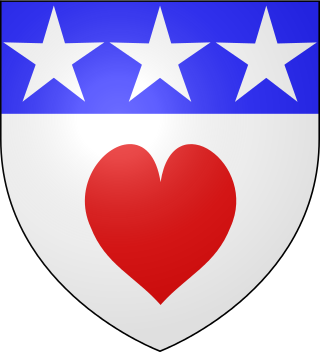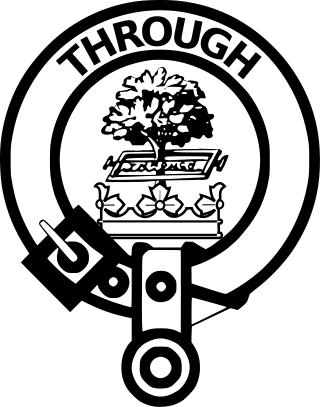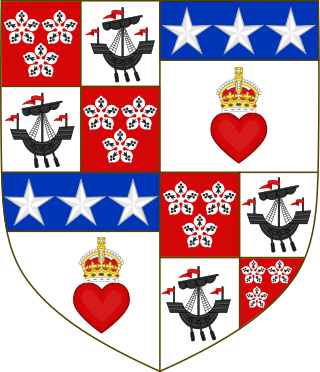
The Mormaer or Earl of Angus was the ruler of the medieval Scottish province of Angus. The title, in the Peerage of Scotland, is held by the Duke of Hamilton, and is used as a courtesy title for the eldest son of the Duke's eldest son.

The Mormaer or Earl of Angus was the ruler of the medieval Scottish province of Angus. The title, in the Peerage of Scotland, is held by the Duke of Hamilton, and is used as a courtesy title for the eldest son of the Duke's eldest son.



Angus is one of the oldest attested mormaerdoms, with the earliest attested mormaer, Dubacan of Angus, known to have lived in the early 10th century, as recorded in the Chronicle of the Kings of Alba . Angus was, according to the doubtful and legendary text de Situ Albanie , one of the seven original mormaerdoms of the Pictish kingdom of Alba, said to have been occupied by seven brothers, of whom Angus (Oengus) was the eldest. [1] Despite this, the mormaers of Angus are among the most obscure of all. After the death of Mormaer Maol Chaluim, in probably about 1240, the mormaerdom passed through the marriage of his daughter Matilda, to the line of the Norman Gilbert de Umfraville.
The lands of Clan Ogilvy, in Angus, was ruled by a mormaer; one of the ancient Celtic nobles of Scotland who became the first earls. [2] The title of Moramer of Angus became Earl of Angus. [2] Gillebride, Earl of Angus, received a Barony from King William the Lion in 1163, [3] and bestowed upon his son, Gilbert, the lands of Wester Powrie, Ogilvy, and Kyneithin. [4] The top left quadrant displays the Ogilvy crest; argent, a lion passant, guardant, Gules, crowned with an imperial crown and collared with an open one, Proper. [5] [ unreliable source? ]
Gilbert de Umfraville inherited the Earldom while in his minority after his father's death in 1245. Gilbert fought on the English side during the first war of Scottish independence until his death in 1308. His heir, second son Robert, also fought on the side of the English and surrendered to King Robert de Brus during the Battle of Bannockburn in 1314. He was released by Robert and treated with the Scots for peace with England. He was ultimately disinherited of his titles. Robert's heir Gilbert continued attempting to recover the Earldom and supported Edward Balliol and other disinherited barons and lords in Scotland.
John Stewart of Bonkyll, Berwickshire, obtained the title Earl of Angus in 1329 in a new line after the forfeiture of the de Umfraville line, though the latter family continued to use the title in England until 1381. [1] This Stewart line ended with Margaret Stewart, countess of Angus in her own right, and widow of Thomas, Earl of Mar. [1]
An illicit affair between Margaret Stewart, Countess of Mar and Angus, and her brother in law, William Douglas, 1st Earl of Douglas (married to the sister of her husband), produced George Douglas, 1st Earl of Angus (c. 1380–1403). The Countess secured a charter of her estates for her son, to whom in 1389 the title was granted by King Robert II. He was taken prisoner at Homildon Hill in 1402, and died in captivity in England. Archibald "Bell-the-Cat" (1453–1514) the powerful adversary of James III, was his great-grandson. [1]
William Douglas (1589–1660) 11th Earl of Angus, was created Marquis of Douglas in 1633. [6] He resigned the title of Earl of Angus, having it recreated with the marquessate, so he was the 1st Earl of Angus in the new creation. He outlived his son Archibald Douglas, Earl of Angus (c. 1609–1655), and was succeeded by Archibald's son James Douglas, 2nd Marquess of Douglas (1646–1699). James' son and heir Archibald Douglas was created Duke of Douglas, Marquess of Angus and Abernethy, Viscount of Jedburgh Forest, and Lord Douglas of Bonkill, Prestoun and Robertoun on 10 April 1703. He died without leaving an heir and the titles acquired with the dukedom became extinct. All his other titles devolved to his distant cousin the 7th Duke of Hamilton, whose descendants hold them still.
|
|
Also Lord Abernethy and Jedburgh Forest
(The Earldom of Angus was regranted with the Marquessate as a courtesy title, used by the eldest son of the Marquess)
Also Marquess of Angus and Abernethy, Viscount of Jedburgh Forest, and Lord Douglas of Bonkill, Prestoun and Robertoun
For later Earls of Angus and Marquesses of Douglas, see the Duke of Hamilton
| Family tree of the: Earls of Angus, Earls of Avondale, Earls of Douglas, Marquesses of Douglas, Earls of Forfar, Earls of Ormond and Marquesses of Ormond, Earls of Ross and Dukes of Ross | |||||||||||||||||||||||||||||||||||||||||||||||||||||||||||||||||||||||||||||||||||||||||||||||||||||||||||||||||||||||||||||||||||||||||||||||||||||||||||||||||||||||||||||||||||||||||||||||||||||||||||||||||||||||||||||||||||||||||||||||||||||||||||||||||||||||||||||||||||||||||||||||||||||||||||||||||||||||||||||||||||||||||||||||||||||||||||||||||||||||||||||||||||||||||||||||||||||||||||||||||||||||||||||||||||||||||||||||||||||||||||||||||||||||||||||||||||||||||||||||||||||||||||||||||||||||||||||||||||||||||||||||||||||||||||||||||||||||||||||||||||||||||||||||||||||||||||||||||||||||||||||||||||||||||||||||||||||||||||||||||||||||||||||||||||||||||||||||||||||||||||||||||||||||||||||||||||||||||||||||||||||||||||||||||||||||||||||||||||||||||||||||||||||||||||||||||||||||||||||||||||||||||||||||||||||||||||||||||||||||||||||||||||||||||||||||||||||||||||||||||||||||||||||||||||||||||||||||||||||||||||||||||||||||||||||||||||||||||||||||||||||||||||||||||||||||||||||||||||||||
|---|---|---|---|---|---|---|---|---|---|---|---|---|---|---|---|---|---|---|---|---|---|---|---|---|---|---|---|---|---|---|---|---|---|---|---|---|---|---|---|---|---|---|---|---|---|---|---|---|---|---|---|---|---|---|---|---|---|---|---|---|---|---|---|---|---|---|---|---|---|---|---|---|---|---|---|---|---|---|---|---|---|---|---|---|---|---|---|---|---|---|---|---|---|---|---|---|---|---|---|---|---|---|---|---|---|---|---|---|---|---|---|---|---|---|---|---|---|---|---|---|---|---|---|---|---|---|---|---|---|---|---|---|---|---|---|---|---|---|---|---|---|---|---|---|---|---|---|---|---|---|---|---|---|---|---|---|---|---|---|---|---|---|---|---|---|---|---|---|---|---|---|---|---|---|---|---|---|---|---|---|---|---|---|---|---|---|---|---|---|---|---|---|---|---|---|---|---|---|---|---|---|---|---|---|---|---|---|---|---|---|---|---|---|---|---|---|---|---|---|---|---|---|---|---|---|---|---|---|---|---|---|---|---|---|---|---|---|---|---|---|---|---|---|---|---|---|---|---|---|---|---|---|---|---|---|---|---|---|---|---|---|---|---|---|---|---|---|---|---|---|---|---|---|---|---|---|---|---|---|---|---|---|---|---|---|---|---|---|---|---|---|---|---|---|---|---|---|---|---|---|---|---|---|---|---|---|---|---|---|---|---|---|---|---|---|---|---|---|---|---|---|---|---|---|---|---|---|---|---|---|---|---|---|---|---|---|---|---|---|---|---|---|---|---|---|---|---|---|---|---|---|---|---|---|---|---|---|---|---|---|---|---|---|---|---|---|---|---|---|---|---|---|---|---|---|---|---|---|---|---|---|---|---|---|---|---|---|---|---|---|---|---|---|---|---|---|---|---|---|---|---|---|---|---|---|---|---|---|---|---|---|---|---|---|---|---|---|---|---|---|---|---|---|---|---|---|---|---|---|---|---|---|---|---|---|---|---|---|---|---|---|---|---|---|---|---|---|---|---|---|---|---|---|---|---|---|---|---|---|---|---|---|---|---|---|---|---|---|---|---|---|---|---|---|---|---|---|---|---|---|---|---|---|---|---|---|---|---|---|---|---|---|---|---|---|---|---|---|---|---|---|---|---|---|---|---|---|---|---|---|---|---|---|---|---|---|---|---|---|---|---|---|---|---|---|---|---|---|---|---|---|---|---|---|---|---|---|---|---|---|---|---|---|---|---|---|---|---|---|---|---|---|---|---|---|---|---|---|---|---|---|---|---|---|---|---|---|---|---|---|---|---|---|---|---|---|---|---|---|---|---|---|---|---|---|---|---|---|---|---|---|---|---|---|---|---|---|---|---|---|---|---|---|---|---|---|---|---|---|---|---|---|---|---|---|---|---|---|---|---|---|---|---|---|---|---|---|---|---|---|---|---|---|---|---|---|---|---|---|---|---|---|---|---|---|---|---|---|---|---|---|---|---|---|---|---|---|---|---|---|---|---|---|---|---|---|---|---|---|---|---|---|---|---|---|---|---|---|---|---|---|---|---|---|---|---|---|---|---|---|---|---|---|---|---|---|---|---|---|---|---|---|---|---|---|---|---|---|---|---|---|---|---|---|---|---|---|---|---|---|---|---|---|---|---|---|---|---|---|---|---|---|---|---|---|---|---|---|---|---|---|---|---|---|---|---|---|---|---|---|---|---|---|---|---|---|---|---|---|---|---|---|---|---|---|---|---|---|---|---|---|---|---|---|---|---|---|---|---|---|---|---|---|---|---|---|---|---|---|---|---|---|---|---|---|---|---|---|---|---|---|---|---|---|---|---|---|---|---|---|---|---|---|---|---|---|---|---|---|---|---|---|---|---|---|---|---|---|---|---|---|---|---|---|---|---|---|---|---|---|---|---|---|---|---|---|---|---|---|---|---|---|---|---|---|---|---|---|---|---|---|---|---|---|---|---|---|---|---|---|---|---|---|---|---|---|---|---|---|---|---|---|---|---|---|---|---|---|---|---|---|---|---|---|---|---|---|---|---|---|---|---|---|---|---|---|---|---|---|---|---|---|---|---|---|---|---|---|---|---|---|---|---|---|---|---|---|---|---|---|---|---|---|---|---|---|---|---|---|---|---|---|---|---|---|---|---|---|---|---|---|---|---|---|---|---|---|---|---|---|---|---|---|---|---|---|---|---|---|---|---|---|---|---|---|---|---|---|---|---|---|---|---|---|---|---|---|---|---|---|---|---|---|---|---|---|---|---|---|
| |||||||||||||||||||||||||||||||||||||||||||||||||||||||||||||||||||||||||||||||||||||||||||||||||||||||||||||||||||||||||||||||||||||||||||||||||||||||||||||||||||||||||||||||||||||||||||||||||||||||||||||||||||||||||||||||||||||||||||||||||||||||||||||||||||||||||||||||||||||||||||||||||||||||||||||||||||||||||||||||||||||||||||||||||||||||||||||||||||||||||||||||||||||||||||||||||||||||||||||||||||||||||||||||||||||||||||||||||||||||||||||||||||||||||||||||||||||||||||||||||||||||||||||||||||||||||||||||||||||||||||||||||||||||||||||||||||||||||||||||||||||||||||||||||||||||||||||||||||||||||||||||||||||||||||||||||||||||||||||||||||||||||||||||||||||||||||||||||||||||||||||||||||||||||||||||||||||||||||||||||||||||||||||||||||||||||||||||||||||||||||||||||||||||||||||||||||||||||||||||||||||||||||||||||||||||||||||||||||||||||||||||||||||||||||||||||||||||||||||||||||||||||||||||||||||||||||||||||||||||||||||||||||||||||||||||||||||||||||||||||||||||||||||||||||||||||||||||||||||||

Marquess of Queensberry is a title in the Peerage of Scotland. The title has been held since its creation in 1682 by a member of the Douglas family. The Marquesses also held the title of Duke of Queensberry from 1684 to 1810, when it was inherited by the Duke of Buccleuch.

Duke of Hamilton is a title in the Peerage of Scotland, created in April 1643. It is the senior dukedom in that peerage, and as such its holder is the premier peer of Scotland, as well as being head of both the House of Hamilton and the House of Douglas. The title, the town of Hamilton in Lanarkshire, and many places around the world are named after members of the Hamilton family. The ducal family's surname, originally "Hamilton", is now "Douglas-Hamilton". Since 1711, the dukedom has been held together with the Dukedom of Brandon in the Peerage of Great Britain, and the dukes since that time have been styled Duke of Hamilton and Brandon, along with several other subsidiary titles.
The Peerage of the United Kingdom is one of the five Peerages in the United Kingdom. It comprises most peerages created in the United Kingdom of Great Britain and Ireland after the Acts of Union in 1801, when it replaced the Peerage of Great Britain. New peers continued to be created in the Peerage of Ireland until 1898.
There are currently two earldoms of Mar in the Peerage of Scotland, and the title has been created seven times. The first creation of the earldom is currently held by Margaret of Mar, 31st Countess of Mar, who is also clan chief of Clan Mar. The seventh creation is currently held by James Erskine, 14th Earl of Mar and 16th Earl of Kellie, who is also clan chief of Clan Erskine.

The Mormaer or Earl of Buchan was originally the provincial ruler of the medieval province of Buchan. Buchan was the first Mormaerdom in the High Medieval Kingdom of the Scots to pass into the hands of a non-Scottish family in the male line. The earldom had three lines in its history, not counting passings from female heirs to sons. Today, it is held by the Erskine family as a peerage. The current holder is Harry Erskine, 18th Earl of Buchan.

The title Earl of Moray, Mormaer of Moray or King of Moray was originally held by the rulers of the Province of Moray, which existed from the 10th century with varying degrees of independence from the Kingdom of Alba to the south. Until 1130 the status of Moray's rulers was ambiguous and they were described in some sources as "mormaers", in others as "Kings of Moray", and in others as "Kings of Alba". The position was suppressed by David I of Scotland some time after his defeat of Óengus of Moray at the Battle of Stracathro in 1130, but was recreated as a feudal earldom by Robert the Bruce and granted to Thomas Randolph, 1st Earl of Moray in 1312.
Earl of March is a title that has been created several times, respectively, in the Peerage of Scotland and the Peerage of England. The title derives from the "marches" or borderlands between England and either Wales or Scotland, and it was held by several great feudal families which owned lands in those districts. Later, however, the title came to be granted as an honorary dignity, and ceased to carry any associated power in the marches.
The Lord of Abernethy was from the 12th century to the 14th century the hereditary holder of the church and lands of the Scottish monastery at Abernethy. It gradually evolved alongside the title Abbot of Abernethy, displacing that term in extant sources by the end of the 13th century. It was held by the descendants of Gille Míchéil, Earl of Fife.

The Mormaer or Earl of Atholl was the title of the holder of a medieval comital lordship straddling the highland province of Atholl, now in northern Perthshire. Atholl is a special Mormaerdom, because a King of Atholl is reported from the Pictish period. The only other two Pictish kingdoms to be known from contemporary sources are Fortriu and Circinn. Indeed, the early 13th century document known to modern scholars as the de Situ Albanie repeats the claim that Atholl was an ancient Pictish kingdom. In the 11th century, the famous Crínán of Dunkeld may have performed the role of Mormaer.
Earl of Ruglen was a title in the Peerage of Scotland. Along with the subsidiary titles Viscount of Riccartoun and Lord Hillhouse, it was created on the 14th of April, 1697, for Lord John Douglas-Hamilton, fourth son of William Douglas-Hamilton, Duke of Hamilton, 1st Earl of Selkirk, and his wife Anne Hamilton, 3rd Duchess of Hamilton. The 1st Earl of Ruglen succeeded as 3rd Earl of Selkirk on the death of his elder brother in 1739. The Earl's only son William, Lord Daer, died in 1742, so on the death of the Earl of Selkirk and Ruglen in 1744, the Earldom of Selkirk passed to his great-nephew, while the Earldom of Ruglen passed to his daughter, Anne, who had married William Douglas, 2nd Earl of March. On her death in 1748, the Earldom of Ruglen passed to her only child William, 3rd Earl of March. He succeeded his first cousin once removed Charles Douglas as 5th Marquess and 4th Duke of Queensberry in 1778.

This page is concerned with the holders of the forfeit title Earl of Douglas and the preceding feudal barons of Douglas, South Lanarkshire. The title was created in the Peerage of Scotland in 1358 for William Douglas, 1st Earl of Douglas, son of Sir Archibald Douglas, Guardian of Scotland. The Earldom was forfeited by James Douglas, 9th Earl of Douglas, in 1455.

Clan Douglas is an ancient clan or noble house from the Scottish Lowlands.

The Clan Hamilton, or House of Hamilton, is a Scottish clan of the Scottish Lowlands.

Douglas-Hamilton is the family surname of the Dukes of Hamilton and Earls of Selkirk. The name originates from the marriage of Anne Hamilton, 3rd Duchess of Hamilton to William Douglas, 1st Earl of Selkirk in 1656. Anne was Duchess in her own right and head of the "House of Hamilton". William was a younger son of the Marquess of Douglas.
George Douglas, 1st Earl of Angus (1380–1403) was a Scottish nobleman and peer.
George Douglas, 4th Earl of Angus, Lord Douglas, Abernethy and Jedburgh Forest was a Scottish nobleman. He was the son of William Douglas, 2nd Earl of Angus and Margaret Hay of Yester. Known as the Great Earl of Angus. He succeeded to the Earldom following the death of his childless brother James Douglas, 3rd Earl of Angus in 1446. He was to become the first Red Chief of Douglas.

Earl of Ormond was a title twice created in the Peerage of Scotland, both times for members of the Douglas family. The related title Marquess of Ormond was created twice in the Peerage of Scotland for members of the House of Stuart.
William Douglas, 1st Marquess of Douglas and 11th Earl of Angus (1589–1660) was a Scottish nobleman.
Archibald Douglas, 1st Duke of Douglas was a Scottish nobleman.
The Decreet of Ranking of 5 March 1606 determined the relative precedence of members of the peerage of Scotland.